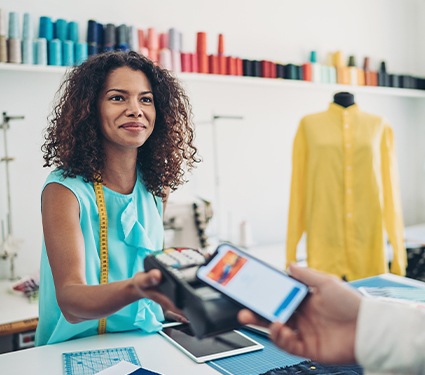Are we moving towards a cashless society?
8-minute read
The pandemic has driven huge changes in how customers shop, amplifying the case for businesses to take a fresh look at the needs of today’s customers. Two of our experts, Marc Pettican, President, Barclaycard Business and Richard Brassey, Head of Business Partnerships, Barclays Partner Finance, explore the key trends as we also ask: what is the future of cash, and are we moving towards a cashless society?

A catalyst for change – the pandemic
In response to the pandemic, online purchases have soared. Supermarkets, for example, saw their online sales in the UK doubling during the first coronavirus lockdown1 . The surge is continuing, with many consumers making online and mobile purchasing their default mode. For many this has created a ‘home delivery’ mentality, with ONS data indicating that shoppers spent nearly twice as much on online groceries in 2020 as in the previous year2.
There have also been major gains for click-and-collect services – with almost 90% of current click-and-collect consumers saying they’ll carry on using these services post-Covid-193.
At the same time, more customers are staying local. Some 64% of consumers are shopping nearer to home than they did pre-pandemic4. We see this as a welcome trend for small businesses as well as the economy.
How business sectors have been innovating
Marc Pettican views the investment seen across multiple sectors as unlikely to revert to how it was. “The customers and businesses we support are looking to maximise the return on those changes. There’s been genuine innovation as businesses have reacted to circumstances.
“Restaurants, for example, have started to undergo a digital transformation, with digital menus, QR codes and pay-at-table options. They’ve embraced online food marketplaces, which consumers have also bought into.”
Coffee houses are looking at new models such as subscription services where customers pay a monthly fee for a fixed number of coffees, then collect in-store. Some large retailers are looking to enable customers to check out online while they’re in-store. “It’s an exciting development,” Marc added. “But, of course, security and anti-fraud measures need to be top of mind.”

Bolstering eCommerce channels in response to pandemic shifts
Customers haven’t just changed the channels they shop through – they’ve also embraced more digital payment solutions. As a result, businesses have had to invest in their eCommerce capabilities to ensure a smooth customer journey through all channels.
Research shows that 38% of consumers have discovered a new payment method over the last 16 months, and 35% have added a card to a digital wallet5. There’s also been a huge rise in app-based mobile payments.
Businesses with sophisticated eCommerce capabilities have been the winners. We expect this trend to continue post-pandemic; for many businesses, it has become a condition of doing business.
“Payments have always been part of the experience, and technology offers the possibility of ‘invisible payments’,” Marc Pettican argues. “Removing friction from payments is becoming a high priority for many more businesses now."
“In-store, another big shift has been towards contactless. We were one of the first payment providers to work with retailers when the limit was increased to £45. There’s been a real paradigm shift – almost 9 in 10 eligible payments are now contactless"6.
“The limit is set to rise further to £100, making it easier for larger shops to be paid by contactless. This may represent a significant change in the relevance of cash.”
With such growth in online and mobile browsing and purchasing, one issue we’re seeing is a rise in basket abandonment. According to Barclaycard research, UK shoppers abandoned £39.4bn worth of items in the last 12 months – more than doubling since 20187. This increases the importance of businesses creating a frictionless eCommerce experience, whether that’s through a mobile app or one-click online buying features.
Flexible online finance options are key
Over the past year, payment providers have had a huge role in helping retailers adapt to an evolving marketplace and shift to online payment solutions to meet customer needs.
“A really important theme has been providing options to customers,” explains Richard Brassey. “For example, there’s been striking growth in the use of retail finance, including Buy Now Pay Later (BNPL) and interest-free credit, especially among younger demographics. In telecoms, consumers have gravitated towards subscription and upgrade models rather than bundled contracts.
“The Barclaycard Monthly Spend Index found that subscription service spending rose 58% in May this year compared to May 20198. As these services become more popular, consumers are changing how they think about ‘ownership’ – moving away from paying in full towards monthly payment models.
“The pandemic has also accelerated consumers’ comfort with making bigger-ticket purchases online and in instalments. This was already being driven by the growth of 0% finance over the last five to 10 years. It’s now normal across most age brackets to have a certain amount going out each month in instalments. Our recent research found that while 46% of consumers were comfortable making high-value (£500+) purchases online before the pandemic, this has jumped to 57%.”9
Developments in technology alongside consumer desire for convenience are shaping today’s purchasing behaviour, and these changes are here to stay. Retailers need to consider whether the payment options they offer are meeting consumer demand and helping their business grow.
There will be a lot more innovation to come in the payments space, which could speed up cash’s decline
So, will we ‘go cashless’?
The answer to this question depends largely on our customers and their needs. As the pandemic has highlighted, convenience plays a vital role in creating a positive experience for today’s consumer. While digital payment solutions have gained popularity and cash usage has declined significantly, cash still has an important role.
In total, there are 1.2m ‘unbanked’ adults in the UK – those that do not have a current account or an alternative e-money account10. Groups most likely to be unbanked include the unemployed, those with no educational qualifications, people working in the gig economy or people who are not digitally savvy. There’s arguably a societal responsibility to make sure that they can continue to use cash.
What’s more, a lot of us still like using cash. According to UK Finance, 34% of consumers use cash because they like the choice and 20% feel it gives them more control11. And, while cash withdrawals remain lower in number than pre-pandemic, the value of the average withdrawal is increasing12.
“During the pandemic, many businesses moved to a card-only or card-first approach,” observes Marc Pettican. “Taking card payments has advantages for businesses beyond health and safety benefits, such as making reporting, accounting and taxation easier. There are also benefits for consumers in going cashless – not carrying cash increases personal safety and improves hygiene. That said, I don’t think we’ll go cashless in my lifetime.”
While the emphasis on digital payment solutions continues to grow, it will take some time for cash to disappear – if it ever does. “The pandemic has shown us that anything is possible, as businesses have innovated and responded,” reflects Richard Brassey.
“There will undoubtedly be more innovation to come in the payment space, which could result in reduced cash use. However, it’s clear that some customers still want to use cash; it’s in businesses’ interests to cater for this demand.”
It’s all about choice
One thing has stood out above all during the Covid-19 pandemic: consumers want choice in how they transact. We may have seen a decline in the number of cash transactions over the past year, but until all consumers decide it’s time, cash is here to stay.
Nevertheless, the landscape will undoubtedly continue to evolve, and the pace of digital transformation may quicken. Offering a choice of payments at the point of purchase will be a key competitive differentiator for businesses. Retailers need to work with payment providers who can help them navigate change, innovate and offer the easy and frictionless methods that customers require.
- The Guardian, 2020
- ONS data, Retail Sales, Great Britain, Dec 2020
- Barclaycard Payments Data, March 2021
- Barclaycard Payments Data, March 2021
- Capgemini World Payment Report 2020
- Barclaycard data: 20 August 2021 vs 27 July 2019 and 23 August 2019. The Barclaycard report combines hundreds of millions of customer transactions with consumer research to provide an in-depth view of UK spending.
- Barclaycard Payments Data, May 2021
- Barclaycard Monthly Spend Index, May 2021
- Barclays Partner Finance Barclays consumer research based on the responses of 1,006 UK consumers, conducted by CrowdTech, June 2021
- FCA, Financial Lives 2020 Survey, Feb 2021
- UK Finance, Future Ready Payments 2030, Feb 2021
- Bank of England, Cash in the time of Covid, Q4 2020

Are the days of cash numbered?
The pandemic has seen consumers turning to alternative payment methods in ever greater numbers. But does that mean they don’t want the choice? We asked Marc Pettican, President of Barclaycard Business, and Richard Brassey, Head of Business Partnerships at Barclays Partner Finance, about the future of payments.
See how our payment experts can help your business.
Complete our call back form today.
Monday-Friday, 9am-5pm.
Share this article